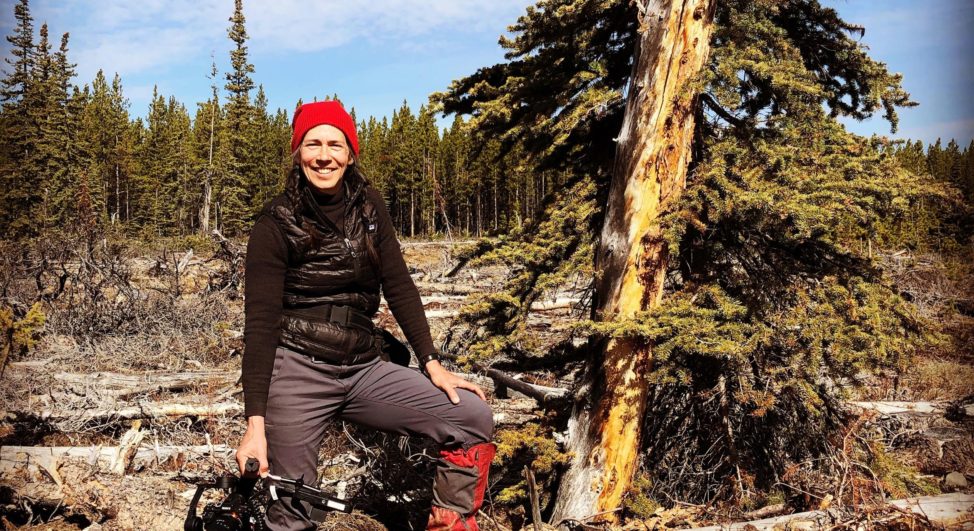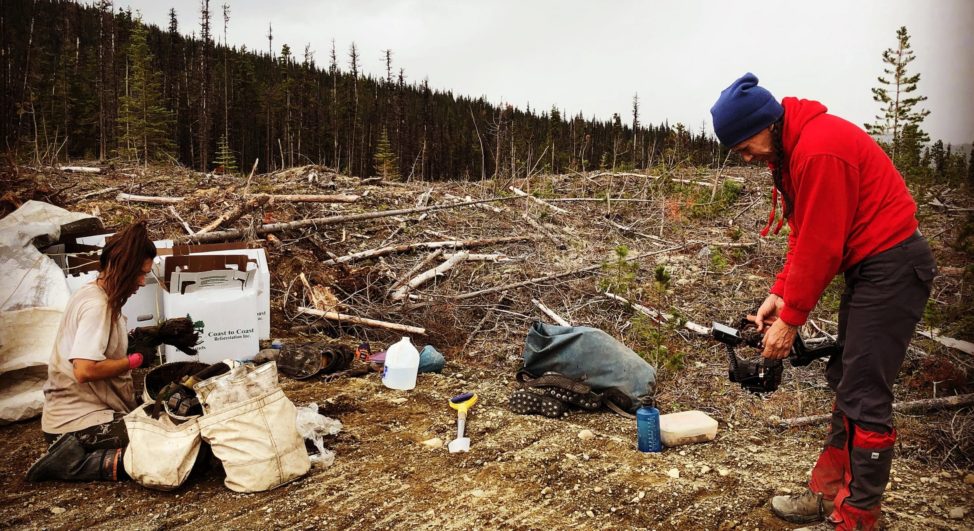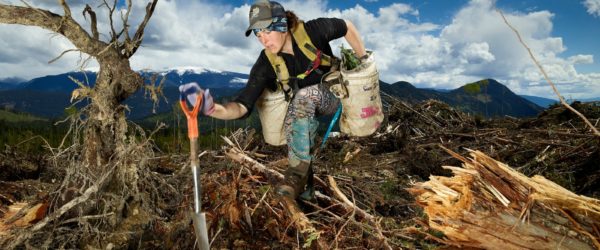Not everyone is cut out to be a tree planter. As revealed in Forest for the Trees, the new documentary by veteran war photographer and former planter Rita Leistner, it’s brutal, lonely, and paid per tree. But for people drawn to it, the time, space, and exercise that the work offers are exactly what they need to resolve emotional challenges, find community, and discover what they’re truly capable of.
Stephanie Sinclair is one such planter. A production assistant on the film who’s also featured in the film, she spent two years planting as she recovered from the trauma of self-harm. Over that time, Stephanie planted upwards of a quarter-million trees.
Forest for the Trees will have its international premiere at DOC NYC today at 6:45PM. The screening will be followed by a Q&A with Leistner, Sinclair and Sound Designer Chandra Bulucon. A 250-page companion book featuring 160 color photographs by Leistner was released in October.
We talked to Rita and Stephanie about the film’s distinct aesthetic, the challenges of winning over a skeptical crew of planters and the emotions involved in returning to a cut block with a camera instead of shovel.
This International Premiere at DOC NYC is part of the Voices of Canada series sponsored by the Consulate General of Canada in New York.

How does it feel to be featured in a world premiere documentary?
Stephanie: It’s very cool. I feel like I’ve been watching it happen for a very long time, so it’s good to see everything become real. Being back in that world in a creative capacity gave me a different perspective on the work. Spending days in the cut block without having to plant trees made me look at it with more of an artist’s perspective. I’m so grateful for that experience.
Being back in that world in a creative capacity gave me an artist's perspective on the work. I'm grateful for that experience. ~ Stephanie Sinclair
What drew you to planting trees to begin with?
Stephanie: I’ve always been outdoors-y and I grew up camping and bike touring with my family. In university I wanted a job that was outside. Looking back, it was risky for me to fly to the interior of British Columbia by myself to a job I didn’t know much about.
A lot of planters say the work changes them – that they learn a lot about themselves. Was this the case for you?
Stephanie: It taught me a lot about the work ethic. And working with Rita taught me a lot about life. The most special thing about her is how she respects people and listens to them. That’s why I think the movie turned out the way it did. We were in a place with people from different backgrounds and she took the time to know them. She was really genuine.
Planters work alone for hours in isolated areas and only see other planters. How does a community form?
Everyone is going through something very difficult together for months on end. That’s rare in life. So you can have the lousiest day ever and people around you understand it completely. There’s an empathy that builds the community.
The COP26 climate conference just wrapped up. How do planters see their work in the context of climate change and environmental sustainability?
Stephanie: Tree planters discuss this a lot. Some go into the work as environmentalists who want to help the planet, but they get pessimistic pretty quickly because they realize they’re really helping the logging industry. There’s a lot of concern now about logging in BC’s old-growth forests. My take is that the industry should leave those ecosystems intact and take the trees I planted instead, because that species has a life span of 80 years. It’s a more sustainable approach.

Trees can help combat climate change through carbon sequestering. But we'll need billions to make that happen. And planting them is brutal labor. ~ Rita Leistner
Rita: The film is about the tree planters themselves, not the industry. But both are evolving. Tree planting wasn’t an occupation until forestry was mechanized in the 1960s, which led to a new awareness that the forests were threatened. The work is transitioning from something that was firmly within forestry to an Anthropocene symptom and solution to climate change. Trees can help combat climate change through carbon sequestering. But we’ll need billions to make that happen. And planting is brutal labor.
How do people cope with the physical rigors of the work?
There’s a lot of crying. There’s a saying that everybody cries in the cut block.
You have to be tough enough that what you get out of it is worth the pain and discomfort, because they’re enormous.
But filmmaking is incredibly difficult, too. I spent 20 years after tree planting as a documentary photographer, but this is my first film. I wanted to parallel these two journeys. You plant a forest one tree at a time, and you make a film one shot at a time. Both have to be worth the pain.
You plant a forest one tree at a time, and you make a film one shot at a time. Both have to be worth the pain. ~ Rita Leistner

You shot outdoors, but the still photos used in the film (and the accompanying book) are lit like studio shots. What was the rationale behind your aesthetic choices?
I’ve always been drawn to light. And I got a lot of my training as a lighting technician in the film industry. Even when I was working in the war zones like Iraq I was the only photographer using a handheld flash. It went against tradition in documentary photography and photojournalism, which emphasizes natural light. But I didn’t care. I like that the lighting controlled the aesthetic of what you’re looking at.
I was limited working in war zones because I could only carry so much gear. By the time I was ready to this film I was excited because I could use the biggest and most expensive lights out there. It was a no-holds-barred effort to use the studio techniques that I had perfected in a rough outdoor environment.
I wanted to recreate the look of heroic figures in classical painting. And I absolutely wanted them to be action shots. ~ Rita Leistner
I wanted to recreate the look of heroic figures in classical painting without influencing the environment. And I absolutely wanted them to be action shots. But the terrain is extremely rough and we were in motion the whole time, so the light had to be held by a human being. My assistant didn’t need to know anything about photography, but they had to be physically strong and quick on their feet and willing to work their ass off because we were going to run backwards through cut blocks and never get enough sleep.
Stephanie: That was me.

What practical challenges did this aesthetic choice present?
Rita: The challenges were similar to those that a sports photographer would have. And because time is money – planters are paid by the tree – the last thing you want to do is slow them down. We had to convince the planters that we wouldn’t get in their way.
I could shoot for a week and not get something that was exactly right. But when I got the short that was right under those circumstances, the exuberance was incredible. My gallerist Stephen Bulger says that some people who see my photos say “Oh, I could do that” and he replies, “I guarantee you, you could not.”
Stephanie: Even access was a challenge. Sometimes we’d walk five kilometers on wet roads through huge puddles knee-deep in mud with heavy gear just to get to the site. Then we had a full day of shooting.
Sometimes we'd walk five kilometers on wet roads through huge puddles knee deep in mud with heavy gear just to get to the site. Then we had a full day of shooting. ~ Stephanie Sinclair
Rita: We also made photographs and time-lapse photography of the forest and the night sky about 50km from the camp. That was dangerous, too, because of cougars and bears.
Stephanie: It was also FREEZING.
Rita: It was magical and unforgettable. And really hard. There’s a scene in the film of one of those nights.
What did the planters say when you approached them to be featured?
Rita: The first question everyone asked me was, Did you plant? Yes. 10 years. And I was a war photographer. They’d reply, Ok, maybe we’ll give you a chance.
It’s about gaining trust. You can only gain trust by being trustworthy, and that takes time. It helped that I had planted together with the owner, Garth Hadley, in the late 80s – and all the planters respect him because he’s been in the industry forever.
Stephanie: The only reason it worked was because Rita was genuinely respectful and wanted to hear people’s stories.
The only reason it worked was because Rita was genuinely respectful and wanted to hear people's stories. ~ Stephanie Sinclair
Rita: You need that trust so that people don’t censor themselves. They have to trust you to do the right thing with their stories. Over the four years, there were only two people who didn’t want their pictures taken but they both came around.
Do you miss it?
Stephanie: I do. I think everyone does.
Rita: I miss some aspects. In my tree planting heydays in the late 80s, I was in unbelievably peak physical condition. My personal best was planting 6,000 trees in one day. I miss the air and the exercise and the community, but it’s definitely out of my system now (laughs).
Learn more:





